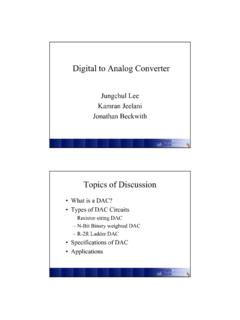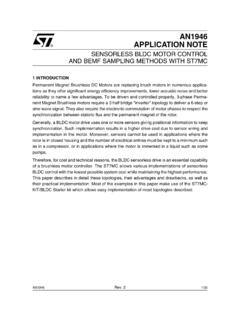Transcription of INTRODUCTION TO DIGITAL FILTERS - UC Davis
1 1 INTRODUCTION TO DIGITAL FILTERSA nalog and DIGITAL filtersIn signal processing, the function of a filter is to remove unwanted parts of the signal, such as random noise, orto extract useful parts of the signal, such as the components lying within a certain frequency following block diagram illustrates the basic are two main kinds of filter , analog and DIGITAL . They are quite different in their physical makeup and inhow they analog filter uses analog electronic circuits made up from components such as resistors, capacitors and opamps to produce the required filtering effect. Such filter circuits are widely used in such applications as noisereduction, video signal enhancement, graphic equalisers in hi-fi systems, and many other are well-established standard techniques for designing an analog filter circuit for a given all stages, the signal being filtered is an electrical voltage or current which is the direct analogue of thephysical quantity ( a sound or video signal or transducer output) DIGITAL filter uses a DIGITAL processor to perform numerical calculations on sampled values of the signal.
2 Theprocessor may be a general-purpose computer such as a PC, or a specialised DSP ( DIGITAL Signal Processor) analog input signal must first be sampled and digitised using an ADC ( analog to DIGITAL converter). Theresulting binary numbers, representing successive sampled values of the input signal, are transferred to theprocessor, which carries out numerical calculations on them. These calculations typically involve multiplyingthe input values by constants and adding the products together. If necessary, the results of these calculations,which now represent sampled values of the filtered signal, are output through a DAC ( DIGITAL to analogconverter) to convert the signal back to analog that in a DIGITAL filter , the signal is represented by a sequence of numbers, rather than a voltage or following diagram shows the basic setup of such a of using DIGITAL filtersThe following list gives some of the main advantages of DIGITAL over analog DIGITAL filter is programmable, its operation is determined by a program stored in the processor'smemory.
3 This means the DIGITAL filter can easily be changed without affecting the circuitry (hardware).An analog filter can only be changed by redesigning the filter FILTERS are easily designed, tested and implemented on a general-purpose computer characteristics of analog filter circuits (particularly those containing active components) aresubject to drift and are dependent on temperature. DIGITAL FILTERS do not suffer from these problems,and so are extremely stable with respect both to time and their analog counterparts, DIGITAL FILTERS can handle low frequency signals accurately. As thespeed of DSP technology continues to increase, DIGITAL FILTERS are being applied to high frequencysignals in the RF (radio frequency) domain, which in the past was the exclusive preserve of FILTERS are very much more versatile in their ability to process signals in a variety of ways; thisincludes the ability of some types of DIGITAL filter to adapt to changes in the characteristics of DSP processors can handle complex combinations of FILTERS in parallel or cascade (series),making the hardware requirements relatively simple and compact in comparison with the equivalentanalog of DIGITAL filtersIn this section, we will develop the basic theory of the operation of DIGITAL FILTERS .
4 This is essential to anunderstanding of how DIGITAL FILTERS are designed and the "raw" signal which is to be digitally filtered is in the form of a voltage waveform described by thefunctionVxt=()where t is signal is sampled at time intervals h (the sampling interval). The sampled value at time t = ih isxx ihi=()Thus the DIGITAL values transferred from the ADC to the processor can be represented by the sequencex, x, x, x, .. 0123corresponding to the values of the signal waveform att = 0, h, 2h, 3h, ..and t = 0 is the instant at which sampling time t = nh (where n is some positive integer), the values available to the processor, stored in memory, arex, x, x, x, .. x0123nNote that the sampled values xn+1, xn+2 etc. are not available, as they haven't happened yet!The DIGITAL output from the processor to the DAC consists of the sequence of valuesy , y, y, y.
5 Y0123nIn general, the value of yn is calculated from the values x0, x1, x2, x3, .. , xn. The way in which the y's arecalculated from the x's determines the filtering action of the DIGITAL the next section, we will look at some examples of simple DIGITAL of simple DIGITAL filtersThe following examples illustrate the essential features of DIGITAL Unity gain filter :y = xnnEach output value yn is exactly the same as the corresponding input value xn:yxyxyxetc001122===..This is a trivial case in which the filter has no effect on the Simple gain filter :y = Kxnnwhere K = simply applies a gain factor K to each input > 1 makes the filter an amplifier, while 0 < K < 1 makes it an attenuator. K < 0 corresponds to aninverting amplifier. Example (1) above is simply the special case where K = Pure delay filter :y = xnn-1 The output value at time t = nh is simply the input at time t = (n-1)h, the signal is delayed by timeh:y = xy = xy = xy = etc0-1102132 Note that as sampling is assumed to commence at t = 0, the input value x-1 at t = -h is undefined.
6 It isusual to take this (and any other values of x prior to t = 0) as Two-term difference filter :y = x - xnnn-1 The output value at t = nh is equal to the difference between the current input xn and the previousinput xn-1:y = x - xy = x - xy = x - xy = x - the output is the change in the input over the most recent sampling interval h. The effect of thisfilter is similar to that of an analog differentiator Two-term average filter :y = x + x2nnn-1 The output is the average (arithmetic mean) of the current and previous input: y = x + x2y = x + x2y = x + x2y = x + etc00-1110221332 This is a simple type of low pass filter as it tends to smooth out high-frequency variations in a signal.(We will look at more effective low pass filter designs later).6. Three-term average filter :y = x + x3nnn-1+ xn2 This is similar to the previous example, with the average being taken of the current and two previousinputs: y = x + x + x3y = x + x + x3y = x + x + x3y = x + x + x3 00-1-2110-122103321As before, x-1 and x-2 are taken to be Central difference filter :y = x - x2nnn-2 This is similar in its effect to example (4).
7 The output is equal to half the change in the input signalover the previous two sampling intervals:y = x - x2y = x - x2y = x - x2y = x - etc00-211-1223310 Order of a DIGITAL filterThe order of a DIGITAL filter is the number of previous inputs (stored in the processor's memory) used tocalculate the current :1. Examples (1) and (2) above are zero-order FILTERS , as the current output yn depends only on the current inputxn and not on any previous Examples (3), (4) and (5) are all of first order, as one previous input (xn-1) is required to calculate yn. (Notethat the filter of example (3) is classed as first-order because it uses one previous input, even though thecurrent input is not used).3. In examples (6) and (7), two previous inputs (xn-1 and xn-2) are needed, so these are second-order may be of any order from zero filter coefficientsAll of the DIGITAL filter examples given above can be written in the following general forms:Zero order:y = axn0nFirst order:y = ax + axn0n1n-1 Second order:y = ax + ax+ axn0n1n-12n-2 Similar expressions can be developed for FILTERS of any constants a0, a1, a2.
8 Appearing in these expressions are called the filter coefficients. It is the values ofthese coefficients that determine the characteristics of a particular following table gives the values of the coefficients of each of the FILTERS given as examples 1 For each of the following FILTERS , state the order of the filter and identify the values of itscoefficients:(a)y = 2x - xnnn-1(b)y = xnn-2(c)y = x - 2x + 2x + xnnn-1n-2n-3 Recursive and non-recursive filtersFor all the examples of DIGITAL FILTERS discussed so far, the current output (yn) is calculated solely from thecurrent and previous input values (xn, xn-1, xn-2, ..). This type of filter is said to be recursive filter is one which in addition to input values also uses previous output values. These, like theprevious input values, are stored in the processor's word recursive literally means "running back", and refers to the fact that previously-calculated outputvalues go back into the calculation of the latest output.
9 The expression for a recursive filter therefore containsnot only terms involving the input values (xn, xn-1, xn-2, ..) but also terms in yn-1, yn-2, ..From this explanation, it might seem as though recursive FILTERS require more calculations to be performed,since there are previous output terms in the filter expression as well as input terms. In fact, the reverse isusually the case: to achieve a given frequency response characteristic using a recursive filter generally requiresa much lower order filter (and therefore fewer terms to be evaluated by the processor) than the equivalent non-recursive filter . This will be demonstrated people prefer an alternative terminology in which a non-recursive filter is known asan FIR (or Finite Impulse Response) filter , and a recursive filter as an IIR (or InfiniteImpulse Response) terms refer to the differing "impulse responses" of the two types of filter .
10 Theimpulse response of a DIGITAL filter is the output sequence from the filter when a unitimpulse is applied at its input. (A unit impulse is a very simple input sequence consistingof a single value of 1 at time t = 0, followed by zeros at all subsequent sampling instants).An FIR filter is one whose impulse response is of finite duration. An IIR filter is onewhose impulse response theoretically continues for ever because the recursive (previousoutput) terms feed back energy into the filter input and keep it going. The term IIR is notvery accurate because the actual impulse responses of nearly all IIR FILTERS reduce virtuallyto zero in a finite time. Nevertheless, these two terms are widely of a recursive filterA simple example of a recursive DIGITAL filter is given byy = x + ynnn-1In other words, this filter determines the current output (yn) by adding the current input (xn) to the previousoutput (yn-1):y = x + yy = x + yy = x + yy = x + etc00-1110221332 Note that y-1 (like x-1) is undefined, and is usually taken to be us consider the effect of this filter in more detail.









